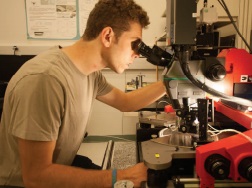
Student Research Spotlight: Superconducting Sensor Arrays
Senior Max Silva-Feaver is working in Professor Betty Young's lab as part of a new collaboration between Stanford, SLAC, SCU and NIST (Boulder) that is funded to build and optimize advanced superconducting transition-edge sensor arrays that will enable new cutting-edge physics experiments in a variety of fields. Applications include precise measurements of the Cosmic Microwave Background, X-ray astronomy with improved energy resolution and imaging sensitivity, and fundamental studies in physics, biochemistry and material science on a beamline of the Stanford Synchotron Radiation Lightsource (SSRL). The collaboration is also working to improve RF-microwave SQUID-based multiplexing technology to advance read-out capabilities beyond what is currently available.
As a member of the new collaboration, Max has helped develop and prepare lab infrastructure by designing and building a high-vacuum pumping station, manufacturing in-house and testing the efficacy of a conductive adhesive for use at 0.05 K, and fabricating custom sample mounts for new sensors and multiplexing chips that will be tested in early 2015. He has also completed formal Class 100 cleanroom training at the Stanford Nanofabrication Facility (SNF), and has started working alongside John Mark Kreikebaum (SCU Physics, ‘12) on the fabrication of micron-scale, thin-film devices.
Before joining Prof. Young’s lab, Max had internships at NIST Gaithersburg and at Asylum Research, where he worked on new atomic force microscope (AFM) techniques. After graduation, he plans to continue to work in physics research labs before pursuing a PhD in condensed matter physics.